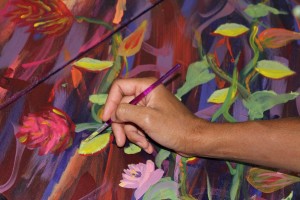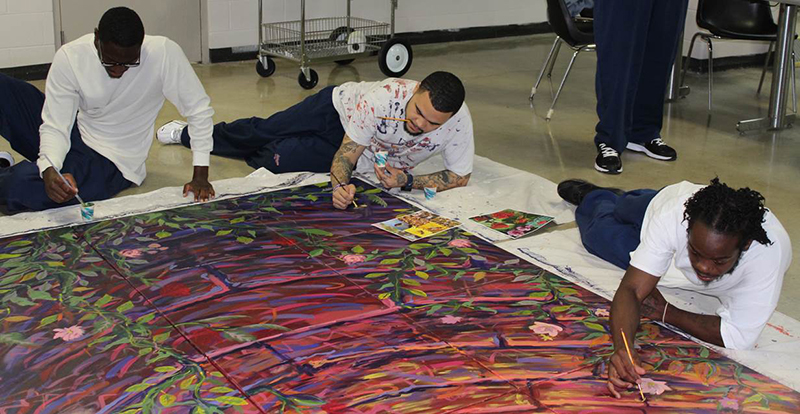Alumna leads public art project at Toledo Correctional Institution

Criminal justice reform is in the spotlight. Across partisan lines, public figures are talking about a need to reform criminal justice policy, especially sentencing and the prison population.
The United States holds 4.4 percent of the world’s population, but 22 percent of its prisoners, according to the Sentencing Project. Roughly 2.2 million people are incarcerated in prisons and jails — a 500 percent increase in the last 40 years — and the effects on children, families and neighborhoods are even farther-reaching. Poor people and people of color are disproportionately impacted. These circumstances, among others, have prompted conversations at the national level about the state of the U.S. criminal justice system.
Community artists, organizers and incarcerated people completed a public art piece inside the walls of Toledo Correctional Institution to contribute to that dialogue at the local level.
The project, a 6-foot-by-14-foot mural, was developed by community art coordinator Emily Numbers (A&L ’14, Honors ’14) in collaboration with People for Change, Art Corner Toledo, and artists Matt Taylor and Yusuf Lateef. A public unveiling was held in November in the lobby of One Government Center.
 People for Change is comprised of incarcerated individuals and UT faculty, students and alumni who organize educational initiatives inside the Toledo Correctional Institution. It is an alumni group of the national Inside/Out Prison Exchange Project, in which university students take a course inside a prison alongside incarcerated people. Other People for Change initiatives include workshops, community speakers and an academic library.
People for Change is comprised of incarcerated individuals and UT faculty, students and alumni who organize educational initiatives inside the Toledo Correctional Institution. It is an alumni group of the national Inside/Out Prison Exchange Project, in which university students take a course inside a prison alongside incarcerated people. Other People for Change initiatives include workshops, community speakers and an academic library.
Numbers took the Inside/Out class as a UT student in 2013. Since then, she has been a part of the People for Change alumni group.
“The Inside/Out Prison Exchange Project opened my eyes to the talent, intellect and desire to make positive change that exists within prisons, and introduced me to the vast injustice that is mass incarceration in the U.S.,” she said.
Numbers, who became interested in the concept of art as a catalyst for social change as a law and social thought student at UT, designed the project to humanize the prison population and to promote civic dialogue on issues surrounding incarceration. The art was painted on a series of 21 2-foot canvasses due to limitations on materials allowed in the prison.
“I learned about the principles of community-based art in Thor Mednick’s Arts Diplomacy class at UT, in which we painted a mural with artist Dave Lowenstein and community members at the Frederick Douglass Center. The elements of dialogue, participation and collaboration were key aspects that I wanted to keep central to this project,” Numbers, communications and public relations specialist in the College of Engineering, said.
Taylor, Lateef and Rachel Richardson, director of Art Corner Toledo, got involved when Numbers invited them to speak to the workshop group about their art in the community. After that initial meeting last spring, the three decided they wanted to continue their involvement with the project. Numbers’ vision and coordination, Taylor and Lateef’s expertise, Art Corner Toledo’s community connections, and the dedication of the incarcerated participants came together to result in this work of collaborative, community art.
Art Corner Toledo helped secure funding from the Lucas County Commissioners, who have a current focus on criminal justice. The Art Supply Depot and the UT Inside/Out Project in the College of Arts and Letters also provided support for materials and supplies.
Over several brainstorming sessions with the artists, organizers and incarcerated participants, the group arrived at the final design for the piece. The imagery was ultimately inspired by the sharing of poetry written by incarcerated individuals and represents the experience of incarceration and the aspirations of the group. Viewers’ perspectives place them at the bottom of a well, looking up toward a bright opening. Both flowers and weeds fill the bottom of the well, and one determined vine makes its way into the light. Several bees are included in the image, both coming and going from the viewer’s perspective.
“To the incarcerated participants, the well represents the physical limitations of the maximum security prison in which they reside, as well as the social barriers that may have led them to the circumstance of incarceration,” Numbers explained. “The flowers indicate the possibility for life and beauty to thrive in unexpected places, and the bees represent the exchange of ideas necessary for that hope to thrive. The bees can be interpreted as teachers, family members or volunteers, for instance, who refuse to turn a blind eye to the damages done by incarceration, and who refuse to turn their backs on individuals who will ultimately return to our community.”
The piece is accompanied by a collective poem written by the incarcerated participants, elaborating on the visual metaphor.
All of the incarcerated participants in this workshop have taken college-level courses through the UT Inside/Out Prison Exchange Project. Many of the discussions leading to the design were centered on the concept of education as the key to reaching post-incarceration aspirations.
Dr. Renee Heberle, professor of political science, brought the Inside/Out Prison Exchange Project to the University in 2010.
“Inside/Out and People for Change give UT students and incarcerated students a unique opportunity to engage and learn with individuals they might otherwise not only never meet, but would perhaps, otherwise, stigmatize and fear,” Heberle, coordinator of the program, said. “It has literally changed lives and career paths of students, on the inside and the outside. The innovative pedagogical model and ongoing opportunities for engagement beyond the classes cultivate democratic and collaborative skills as students confront issues related to social justice and create social change.
“This mural represents the underlying principles and values of Inside/Out in the collaborative process of its creation, while being a beautiful and aesthetically important work of art on its own terms.”
The art made its debut at One Government Center and is now hanging at the Lucas County Common Pleas Court. It will be installed in public spaces in Toledo. After completing its tour around the city, the work will be donated to a local organization selected by the participants.
“It is the intention of the incarcerated participants that this public art project will serve as a sign of hope for all viewers who may face barriers or confines of their own,” Numbers said.
“As the project travels around Toledo, it carries hope for the transformation of the criminal justice system, hope for incarcerated people seeking meaning and growth despite their circumstances, and hope for anyone facing conditions that confine, imprison or isolate.”







